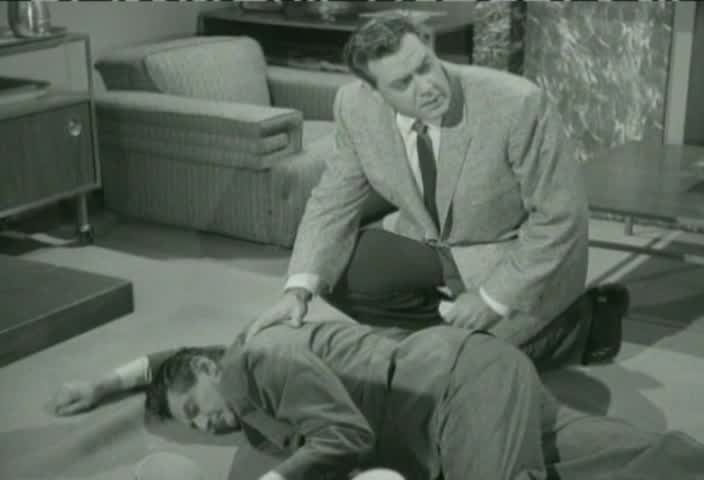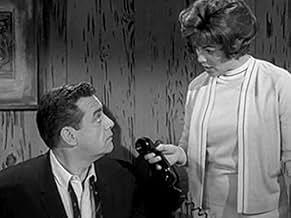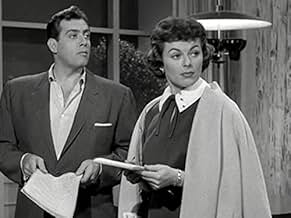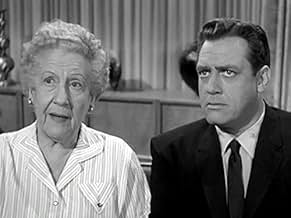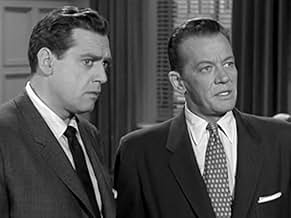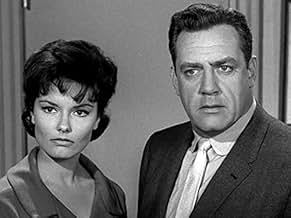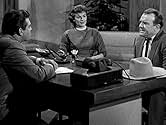Un abogado de defensa criminal, trabaja con los casos más difíciles para ayudar a los inocentes.Un abogado de defensa criminal, trabaja con los casos más difíciles para ayudar a los inocentes.Un abogado de defensa criminal, trabaja con los casos más difíciles para ayudar a los inocentes.
- Ganó 3 premios Primetime Emmy
- 7 premios ganados y 7 nominaciones en total
Explorar episodios
Argumento
¿Sabías que…?
- TriviaWhen Raymond Burr missed several episodes due to illness, he was replaced by several guest attorneys who were played by Bette Davis, Walter Pidgeon, Hugh O'Brian, Michael Rennie, and Mike Connors.
- ErroresPerry Mason's office is given as on the 9th floor of the fictional "Brent Building" in Los Angeles, and has a distinctive terrace outside (as does the next-door office in S.8 Ep. 30). However, establishing shots of the exterior use a photo of a plain-sided office building with no balconies or terraces on the 9th floor, or anywhere else.
- Citas
Hamilton Burger: Incompetent, irrelevant, and immaterial!
- ConexionesFeatured in El jarro de miel (1967)
Opinión destacada
Perhaps the most successful formula show in the history of TV. An interesting question is why, since the lead characters never varied, the outcome was predictable, and the plots could at times defy expert analysis. To me, that sounds pretty boring. So why did I faithfully watch the first runs and still catch the reruns when I can, and why did the series catch the fancy of so many others as it still does. Here are some conjectures.
Mason, Street, and Drake are more than a team-- they are a family. The chemistry among them is so good it's almost spooky. Burr's Mason is nothing if not masterful both inside the courtroom and out. He's a strong father-figure, while Hale's Della Street is the perfect secretary, sweet, attractive and highly efficient. Not quite a mother-figure (after all, this is a chaste family), she's the perfect older sister. And Hopper's Paul Drake is clever, charming, and slightly rakish. All in all, he's the perfect younger brother. Though each is a professional, together they operate as a loyal family unit. And when their final scene rolls around (The Final Fadeout, 1966), we're happy to know they will remain together even though we (the viewers) won't be with them.
The key here is Burr's grasp of character. After all, Mason wins week after week-- he never misses. What's more, he shows up the guardians of law and order week after week. If not done right, Mason would be an easy character to dislike. But Burr's Mason is never smug, never immodest, and always low-key, so we don't resent his near god-like status. This is a real tribute to Burr and the show's producers, who managed to walk a very fine line. There's one other character point worth noting. Mason's personality is the only one of the five (Burger and Tragg included) to alter. In the early episodes, he smokes, wears loud jackets, and occasionally flirts. But with the show's success, he's transformed into a paragon of virtue, probably because his character has come to stand for the quality of criminal justice in America. Shrewdly, the producers would take no chances with their golden egg.
The engaging quality of the stories varies little, an unusual feature for any formula show. That's likely because the script-writers worked with variations on six or seven basic plots. After all, they had to come up with thirty-plus mysteries every year for nine years. And each episode had to have a plausible list of suspects with a story line to unravel, which is a pretty heavy load. Then too, each entry had to have a larger than average cast of capable actors as suspects. Watching the re-runs, we see just about every familiar face from that era (one of the joys of catching the re-runs). Executive producer Gail Patrick Jackson deserves a lot of behind-the-scenes credit, since I'm sure this was not an easy series to put together week after week.
I had never thought of the show as film noir. But other reviewers have correctly pointed this out. Indeed, there are elements of noir in many of the first half hours, where the mystery sets up. Many of these were done in shadow, with strong emotions and a heavy atmosphere of doom, which distinguishes the series. For, overall, there was very little noir from any series during that sunny era. Frankly, it's that part I always enjoyed more than the courtroom scenes with their high-key lighting and extended dialogue. The general excellence of these first half- hours is another reason, I think, for the show's unusual success.
The mystery angle remains an attraction for many. It's fun, for those who want, to try to figure out the culprit. We know he or she will be exposed and the loose ends tied-up by hour's end. But the entries can be enjoyed for their drama alone. The witness-stand confessions served as a chance for neglected feature players to show their acting chops. Some of these were truly memorable. My favorite is from that great unsung actress of the era, Constance Ford. Watch her split personality emerge under Mason's perceptive grilling (The Case of the Deadly Double, 1958). It's a dramatic tour-de-force, as good as anything from the movies of the time. Many of the confessions were also poignant. The culprit could be seen as a sympathetic character, driven to murder by larger forces. And though, the epilogue (usually in Mason's office) often ended on a humorously upbeat note, the confessions remain the dramatic high point.
These are some of my best guesses. I expect there's another, not so flattering reason. Many of us, of course, have a nostalgic attachment to those younger years, which, I suppose, is only natural. Nonetheless, there is something timeless about the brave knight rescuing unfortunates in distress (in this case, usually a shapely blonde or brunette). In fact, the Mason show was predicated on that venerable premise. And even though Mason-as-ideal-defense-attorney would probably not work in today's post-Vietnam era, the key plot elements endure ( understandably, the series ended, just as the war in south-east Asia heated up). Greed, jealousy, ambition-- this is the stuff of high drama, while the Mason show used them effectively inside a format that fit its time. But the elements themselves remain timeless. And in that sense, so does the series.
Mason, Street, and Drake are more than a team-- they are a family. The chemistry among them is so good it's almost spooky. Burr's Mason is nothing if not masterful both inside the courtroom and out. He's a strong father-figure, while Hale's Della Street is the perfect secretary, sweet, attractive and highly efficient. Not quite a mother-figure (after all, this is a chaste family), she's the perfect older sister. And Hopper's Paul Drake is clever, charming, and slightly rakish. All in all, he's the perfect younger brother. Though each is a professional, together they operate as a loyal family unit. And when their final scene rolls around (The Final Fadeout, 1966), we're happy to know they will remain together even though we (the viewers) won't be with them.
The key here is Burr's grasp of character. After all, Mason wins week after week-- he never misses. What's more, he shows up the guardians of law and order week after week. If not done right, Mason would be an easy character to dislike. But Burr's Mason is never smug, never immodest, and always low-key, so we don't resent his near god-like status. This is a real tribute to Burr and the show's producers, who managed to walk a very fine line. There's one other character point worth noting. Mason's personality is the only one of the five (Burger and Tragg included) to alter. In the early episodes, he smokes, wears loud jackets, and occasionally flirts. But with the show's success, he's transformed into a paragon of virtue, probably because his character has come to stand for the quality of criminal justice in America. Shrewdly, the producers would take no chances with their golden egg.
The engaging quality of the stories varies little, an unusual feature for any formula show. That's likely because the script-writers worked with variations on six or seven basic plots. After all, they had to come up with thirty-plus mysteries every year for nine years. And each episode had to have a plausible list of suspects with a story line to unravel, which is a pretty heavy load. Then too, each entry had to have a larger than average cast of capable actors as suspects. Watching the re-runs, we see just about every familiar face from that era (one of the joys of catching the re-runs). Executive producer Gail Patrick Jackson deserves a lot of behind-the-scenes credit, since I'm sure this was not an easy series to put together week after week.
I had never thought of the show as film noir. But other reviewers have correctly pointed this out. Indeed, there are elements of noir in many of the first half hours, where the mystery sets up. Many of these were done in shadow, with strong emotions and a heavy atmosphere of doom, which distinguishes the series. For, overall, there was very little noir from any series during that sunny era. Frankly, it's that part I always enjoyed more than the courtroom scenes with their high-key lighting and extended dialogue. The general excellence of these first half- hours is another reason, I think, for the show's unusual success.
The mystery angle remains an attraction for many. It's fun, for those who want, to try to figure out the culprit. We know he or she will be exposed and the loose ends tied-up by hour's end. But the entries can be enjoyed for their drama alone. The witness-stand confessions served as a chance for neglected feature players to show their acting chops. Some of these were truly memorable. My favorite is from that great unsung actress of the era, Constance Ford. Watch her split personality emerge under Mason's perceptive grilling (The Case of the Deadly Double, 1958). It's a dramatic tour-de-force, as good as anything from the movies of the time. Many of the confessions were also poignant. The culprit could be seen as a sympathetic character, driven to murder by larger forces. And though, the epilogue (usually in Mason's office) often ended on a humorously upbeat note, the confessions remain the dramatic high point.
These are some of my best guesses. I expect there's another, not so flattering reason. Many of us, of course, have a nostalgic attachment to those younger years, which, I suppose, is only natural. Nonetheless, there is something timeless about the brave knight rescuing unfortunates in distress (in this case, usually a shapely blonde or brunette). In fact, the Mason show was predicated on that venerable premise. And even though Mason-as-ideal-defense-attorney would probably not work in today's post-Vietnam era, the key plot elements endure ( understandably, the series ended, just as the war in south-east Asia heated up). Greed, jealousy, ambition-- this is the stuff of high drama, while the Mason show used them effectively inside a format that fit its time. But the elements themselves remain timeless. And in that sense, so does the series.
- dougdoepke
- 24 dic 2006
- Enlace permanente
Selecciones populares
Inicia sesión para calificar y agrega a la lista de videos para obtener recomendaciones personalizadas
Detalles
- Tiempo de ejecución1 hora
- Color
- Mezcla de sonido
- Relación de aspecto
- 1.33 : 1
Contribuir a esta página
Sugiere una edición o agrega el contenido que falta


